Breeding features
- Rooting cuttings. This is the best way to propagate pelargonium if it is necessary to preserve varietal characteristics.
Cuttings can be taken from early spring to autumn. Do not use cuttings taken in winter for propagation, as they are characterized by a low level of growth hormones.
For the cutting, the apical parts of the shoots are chosen. After removing the lower leaves, an oblique cut is made, which must be dried. Root-stimulating drugs are not required for pelargonium. As a soil, you can use a mixture of peat and sand in equal proportions.
Watering is necessary only when the soil dries up. For the second watering, it is recommended to add a systemic fungicide.
- Reproduction by seeds. You can buy seeds of hybrids of the first and second generations. Due to the fact that pelargoniums grown in this way do not always retain varietal characteristics, this breeding method is not popular among flower growers.
Since pelargonium can be of various types and varieties, we suggest reading about royal, ivy, pink, rosebud, garden, fragrant, yellow, ampelous, dwarf.
Planting Pelargonium Lake
Lake - Pelargonium is unpretentious, but it is important to choose optimal conditions for the plant
Choosing a place and a pot
Like all domestic geraniums, Lake prefers bright areas on the south side.
However, it is very important to protect the “green pet” from direct UV rays by lightly shading with tulle. Draft is unacceptable, but culture loves fresh air, so you need to provide constant ventilation
The pot should be chosen based on the size of the bush, taking into account the fact that this geranium does not like "relocation". Models of a rounded shape up to 15 cm in diameter and up to 20-30 cm high look beautiful. But these sizes are relevant for an adult plant. For planting a cutting, you can choose a regular plastic cup.
Note! The diameter of the container should not be too large, otherwise the pelargonium will begin to develop the root system, from which the green mass and flowering will suffer

A very beautiful plant will certainly respond to competent care and will thank the grower with stunning inflorescence caps
Priming
A drainage layer is required, for example, from gravel, expanded clay, vermiculite. It will help prevent root rot. The soil can be bought ready-made for geraniums. Or mix it yourself from turf, humus and coarse river sand.
Common diseases and pests
With improper care, the plant can get sick:
- If the pelargonium has ceased to bloom, and the internodes become thinner and elongated, then this indicates insufficient illumination at the location of the plant. It is necessary to take the pelargonium pot to a more illuminated place.
- Yellowing leaves and falling flowers are a symptom of a violation of the water regime. The soil is either too dry or too moist. The watering schedule needs to be revised.
- If the leaves of the pelargonium turn red, this may indicate that the air is too cool for the plant. Normalization of the temperature regime is required.
- Poor ventilation, waterlogging, dampness can lead to the appearance of a gray coating - gray rot. After removing the damaged elements, the pelargonium should be placed in more suitable conditions.
- Dark depressed spots at the base of the stem indicate rotting, which was caused by waterlogging of the soil. In this case, the plant cannot be saved.
The blooming beauty can be affected by pests. Among the most common:
- Whitefly is a small white butterfly hiding on the underside of leaves. This pest carries viral infections, and its feces are the source of the development of sooty fungi that harm the plant species. You can cope with whitefly with chemicals.
It will take at least two insecticide treatments with a break per week. Various drugs can be used to enhance the effect.
- A mobile mealybug covered with a waxy white coating greatly inhibits the growth of pelargonium. The presence of this parasite is indicated by sugary secretions and a sooty fungus on them. To protect the plant from the worm, it is necessary to regularly remove all damaged or dried leaves and keep the pelargonium clean.
You can get rid of the parasite by spraying the bush at weekly intervals with one of the systemic insecticides, previously with a soft cloth or cotton wool soaked in soapy water, clearing the pelargonium from worms and their secretions.
- Aphids are especially dangerous in the spring, when the plant grows after winter dormancy. Aphid infestation can be identified by deformed flowers, twisted yellowed leaves, sticky secretions. To combat aphids, contact or intestinal insecticides are used.
Popular varieties
There are so many varieties of pelargonium that it will be rather difficult to list them all. Basically, they differ in the size of the bush, the color and splendor of the inflorescence, sometimes in the leaves. The most popular varieties and their distinctive features will be listed here.
Ludwigsburger Flair. This variety is distinguished by its multi-colored petals. Flowers of such pelargonium have white-pink shades interspersed with green. The plant does not grow very large and belongs to dwarf, but at the same time it has very large and lush inflorescences.
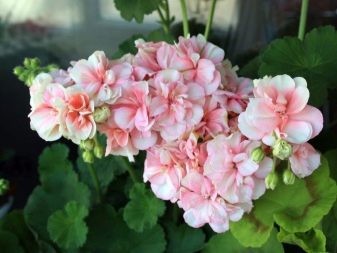
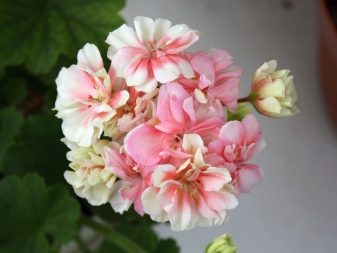
"Silk Lagoon". The bushes that belong to this variety are distinguished by their diminutiveness and lush inflorescences. The color of the flowers can range from light peach to coral. The flower petals are folded, as if pleated, which adds visual doubleness to the flowers.

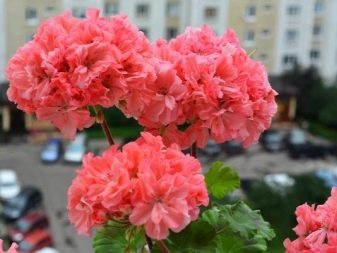
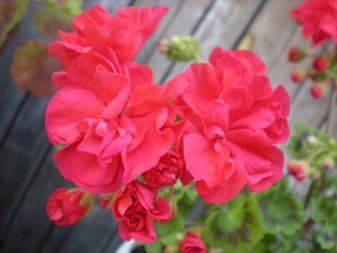

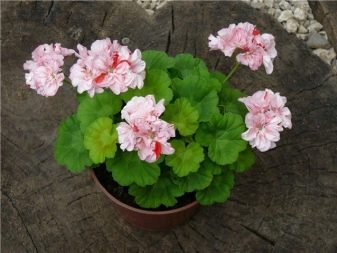
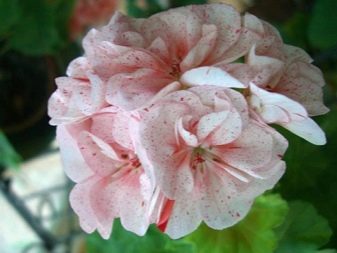
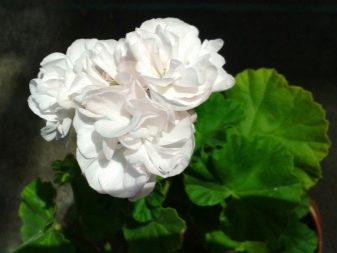
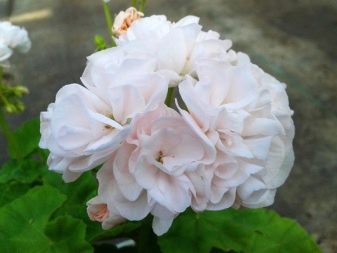
"Silk Aurora". The flowers look double with densely planted petals. The color in peach tones can be modified. If the flowering plant is placed in a cooler place, then light rims will appear on the petals.

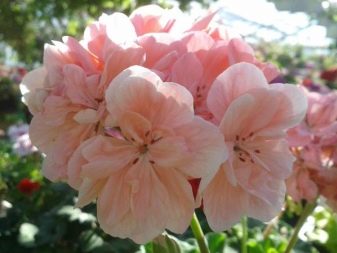
"Silk Alchemist". The variety is distinguished by completely atypical "open" flowers for pelargoniums. Visually, they even resemble pansies or violets. But the inflorescence is the same as in all plants of the species - lush and similar to a ball. The color of the flowers is unusually neon, bright and eye-catching: the main color of the petals is lilac-purple, at the base of the petal there are white contrasting spots.
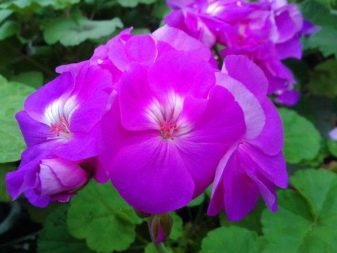
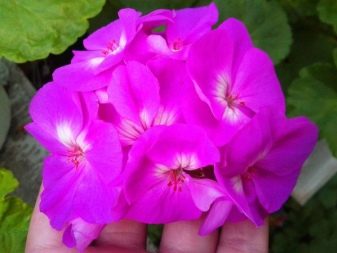
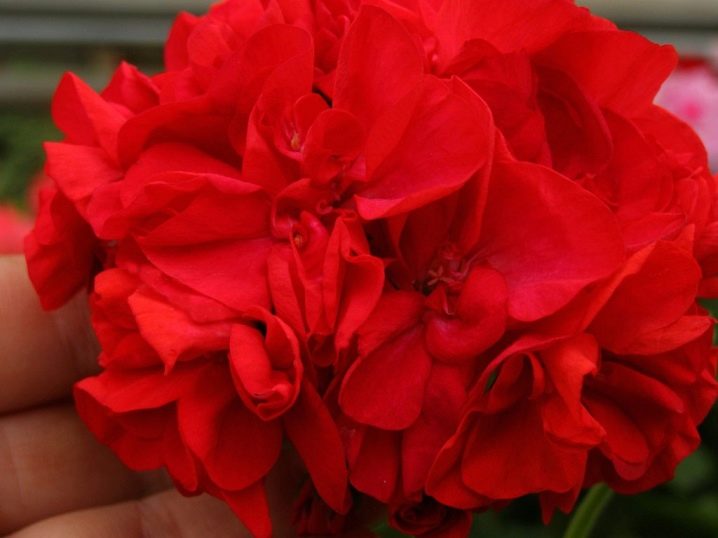
"Silk Moira". A characteristic feature of Moira is the diminutiveness of the bush, which makes it a desirable guest on any windowsill. For all its diminutiveness, this variety has large inflorescences in apricot tones. Sometimes there are more pink variations.

"Silk Lyrics". The flowers of the variety have a very delicate and warm pink color of the petals with a white underside. The inflorescences look very dense and dense, as if curly or double.

"Silk openwork" and "Silk moire". Atypical varieties for pelargonium. The flowers have long, elongated petals sticking out to the side. Visually, these varieties are combined with ordinary pelargoniums only with umbrella leaves. The color of the petals of the first is in coral pink tones, the second is pale pink with dark pink veins along the entire length of the petal.
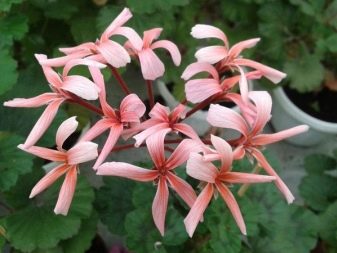
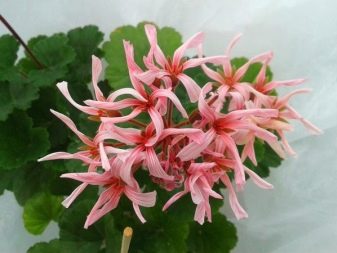
"Silk bird". The flowers of this variety are open, with large petals. The main color is white, but from the base and almost to the very tips of the petals there are bright crimson specks, like specks of quail eggs.
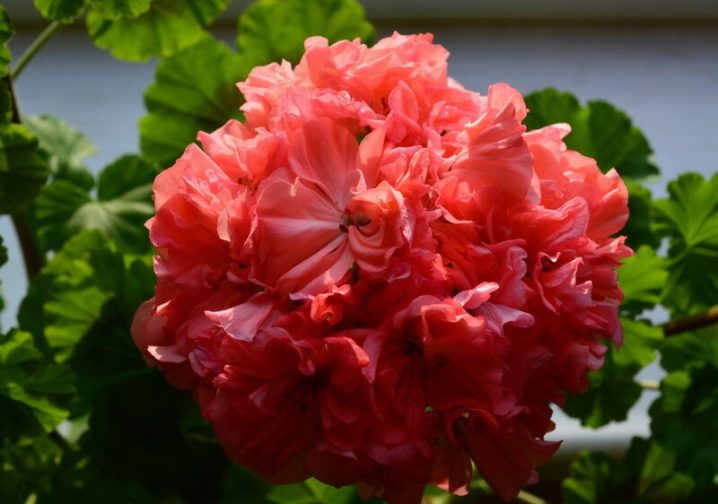
"Silk of the Marquis". The plant has deep purple flowers with white spots at the base of the petals. The inflorescences of the bush are large and lush.
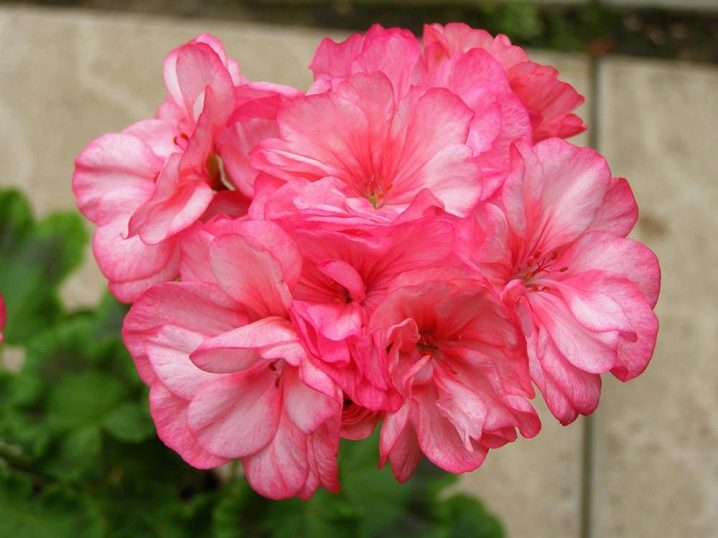
Pelargonium is white. The name of the variety is associated with the snow-white flowers with which it blooms.Flowers in white pelargonium do not have doubleness, the petals are large, open in different directions (like in violets).

How to take care of it properly?
The optimum temperature is 17-23 degrees. At temperatures below 12 degrees, the plant stops blooming. Too high temperatures will also negatively affect flowering. Pelargoniums are quite calm about drought, and excess moisture can lead to fungal diseases.
Therefore, watering should be done as needed - when the topsoil is dry. With each watering in the spring and summer season, it is advisable to introduce top dressing. For rooted cuttings, fertilizers with a high nitrogen content should be used, for young plants - a complex universal fertilizer.
For adult plants, the top dressing should contain potassium before flowering. To maintain good flowering and maintain shape, it is recommended to prune every spring, leaving three buds from last year's growth. In the summer, you can form a bush by pinching the shoots.
In the fall, it is best to gradually lower the temperature and watering frequency to slow down the growth of pelargonium. Otherwise, under conditions of low light, stretching the plant can lead to its depletion. Pruning in the fall is not recommended. Pelargonium winter is best spent in a greenhouse or on a warm balcony with good lighting.
The temperature in winter must be kept between 6 and 15 degrees. If the crown is too dense, then the plant must be thinned to maintain good air circulation. This is a good prevention of fungal diseases. Watering in winter should be carried out so that the topsoil always remains dry.
Another wintering method is to preserve the rooted cuttings, in which case the mother plant is destroyed. The dormant period lasts about three months - from November to February. With increasing daylight hours, pelargoniums wake up.
ADVICE. After the winter rest, it is necessary to remove weak and diseased branches and leaves. For uniform growth, it is necessary to systematically turn the plant every 2-3 days.
Landing
It is advisable to plant a beauty in mid-April or early May, when the soil is already well warmed up.
- Before planting large seeds of Salmon pelargonium, it is advisable to wipe it a little with fine sandpaper.
Reference! Quality planting material can be purchased at specialized stores. - For planting, it is necessary to fill a wooden box with nutritious soil.
- Then make grooves at a distance of 2-3 cm.
- Place the seeds every 1.5 cm, lowering them to a depth of 1 cm.
It is not necessary to cover the plantings with earth, it is enough to cover it with a film.
- The sprouts will appear in 14-20 days. After they have formed 2 leaves, they can be transplanted in containers with a diameter of no more than 10 cm.
- Pour the soil to the edges of the pot, and make a depression in the center.
Pelargonium is a light-loving plant, so choose sunny places for planting.
The flower tolerates heat, drought and cold well. It is desirable to feed with fertilizers with a low nitrogen content. The plant does not need careful care, but hypothermia, lack of light and moisture can provoke bacterial wilting.
Check that there is no stagnation of water and waterlogging of the soil. Remove dried flowers promptly.
Attention! In spring and summer, pelargonium should be fed with mineral and organic fertilizers once a week. For abundant and lush flowering, you can process the flower with cycodel.
Lighting and location
Direct sunlight is dangerous for Salmon pelargonium. In this connection, it is not recommended to plant it in an open area.
A darkened place under a bush or tree is the most comfortable conditions for a flower. To prevent infection with various ailments - protect the culture from other plants.
Soil requirements
Pelargonium can adapt well, grow and bloom for a long time in slightly acidic soil.Due to the weak root system, the flower needs nutritious and loose soil - humus, compost, peat.
Peculiarities
The type of pelargonium, which so confidently settled in the pots of housewives and other lovers of indoor flowers, is terry pelargonium. This species is considered one of the most tenacious and beautiful. It meets all the requirements for decorative colors. Terry pelargonium has many different varieties that differ in their descriptions, but have the same care methods.
Despite their rather compact size, most pelargonium varieties bloom in lush and vibrant flowers. It also has the fact that with proper care the plant can bloom almost all year long - 9-10 months a year. This feature only adds to the love for her as an ornamental plant.
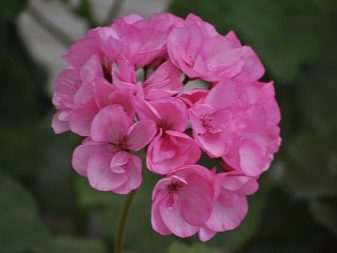

Pelargonium can survive in almost any conditions. Even when it is poorly looked after and does not provide everything necessary, the flower fights for its life to the last.
Pelargonium is loved not only for its beautiful flowers and enviable vitality. This plant is equally comfortable both on the windowsill in a pot and on a flowerbed in cities with a relatively warm climate, which makes it versatile.


Where and how to plant it: rules, tips and instructions
For planting Pelargonium Silk, you must use a special soil. After five years of life, it is advisable to update the plant using rooting of the cuttings. In summer, pelargonium can be planted in open ground or the pot can be taken out into the open air.
After the formation of the first 10 leaves, it is necessary to remove the apical growth point of the cuttings to stimulate the growth of lateral shoots. As the bush grows, you need to regularly pinch the plant for further lush and abundant flowering.
ATTENTION. During the season, young pelargonium must be carefully transshipped several times into a larger pot
The plant should not immediately be given a large space; for one-year-old bushes, the radius of the pot should not be more than 7 centimeters.
Lighting and location
Pelargonium Silk loves light, tolerates direct sunlight well. But if the plant is in a closed room, where light enters through the glass, then the bush may overheat. In this case, the plant must be protected from sun exposure.
Soil requirements
Pelargonium feels comfortable in light neutral soil. You can use a soil containing coarse sand, because it makes the soil breathable. It is recommended for young plants to add peat, sand, perlite to the soil. this lightens the soil.
When buying a mixture, it is best to choose a specially formulated for pelargoniums. Sometimes purchased soil is required to be mixed in a certain proportion with ordinary soil. Such features will be indicated on the packaging.
Pelargonium Silk will thrive if the selected soil is:
- slightly acidic or neutral;
- with enough nutrients;
- without over-compaction.
Basic rules of care
Top dressing
Once every 2-3 weeks, after moistening the soil, it is necessary to fertilize.
It is recommended to use complex mineral formulations containing magnesium, potassium and phosphorus.
Due to the high risk of pests, it is advisable not to use fresh manure. It is recommended to apply fertilizers before and after flowering.
Watering
Pelargonium Salmon needs moderate watering. Watering is desirable 1-2 times a week. An excess of moisture negatively affects the plant. For irrigation, you need to use soft and settled water. If water gets on leaves and petals, it can cause burns.
Pruning
In order for the beautiful pelargonium to actively bloom and grow, you need to regularly prune, slightly pinching the tops of the shoots.
Care and reproduction of perennial geranium
Both indoor and garden perennial geraniums do not require special requirements for planting and caring for them. They are not whimsical.But in order for the plant to have a presentable appearance, it bloomed profusely - novice gardeners should take on a few rules:
The soil for geraniums should be chosen nutritious and loose, rich in humus - if the plant grows on the street, it requires shelter for the winter.
- Dried leaves should be removed regularly - if not done, fungus can often form on them and infect healthy plants.
- The plant is light-requiring and loves well-lit areas, but it is optimal to plant or put in a flowerpot in partial shade or light shading.
- Geranium will bloom profusely to delight with bright greens with regular feeding - at the beginning of spring it is recommended to apply nitrogenous fertilizers in their composition, then complex fertilizers throughout the year.
- It is recommended to transplant a plant no earlier than once every 4 tons - geranium does not like to be disturbed and therefore a violation of the root system can adversely affect its growth and development.
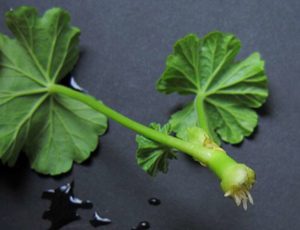
Geranium propagation occurs with the help of seeds, cuttings and dividing the bush. The easiest breeding method is to divide the bush. It is enough to divide the mother bush with a sharp knife so that each of the new parts has its own roots, at least one growth point. After separation - sprinkle the place of dissection with activated carbon and plant in a pot or open ground.
A more laborious process is propagation by cuttings. In this method, with the help of a sharp knife, a stem 5-7 cm long is cut off from the mother bush, so that there are 3 leaves on the stem, letting it lie down so that the cut site dries up. After that, you can plant it in a moist, nutritious soil or put it in a container with water, letting the roots germinate, and after 12-14 days, transplant it into the soil.
The propagation of geraniums by seeds is the most laborious process of breeding geraniums and it is not always possible to obtain a mother variety from them. The seeds themselves are placed in the refrigerator for a day before planting, after which they are sown in a nutritious, loose substrate - they are sprinkled with sand and covered with a film. In winter, seedlings may appear in 3 months, in summer - after a month and a half.
Breeding features
Pelargonium silk can reproduce in several ways, among them:
- Cuttings. It is better to remove cuttings in the warm season, when the plant is in a period of active growth.
- We carefully cut off the apical parts of the shoot, with an oblique cut.
- We leave the stalk in water for several days until the roots appear.
- Planting is carried out in the soil obtained using a mixture of equal parts of peat and sand.
- Seeds. Florists do not often use this method, because species characteristics are not preserved this way. The seeds are left in warm water for a while, and then planted in a similar soil.
It is better to give preference to the cuttings method, which allows you to fully preserve the species characteristics, and the plant quickly adapts and begins active growth.
There are many types of pelargonium, for example, garden, dwarf, fragrant, terry, rosebud, ampel, tulip, ivy, variegated.
A variety of varieties, differing in flowering and leaf shape, will help everyone to choose a flower that fits perfectly into the overall interior of the apartment. And properly selected care will preserve the healthy appearance of pelargonium silk and allow it to bloom regularly and delight the owner with lush flowering.
Develop your own flower care system and regularly inspect it for diseases and pests, then the plant will live a long and wonderful life.
Diseases and pests
When breeding pelargonium, there will be no problems if you provide it with full care.
But when an unpleasant thing happens - the flower begins to hurt or is attacked by pests - it is important to notice and eliminate this in time. This will help save the plant.
The main danger for pelargonium is improper care.It is he who entails the onset of symptoms that can lead to the death of the flower.
- A gray bloom appears on the plant - a manifestation of gray rot. Reasons: constant dampness, waterlogged soil in a pot, or poor ventilation. Parts of the plant that have undergone gray rot must be removed, and the causes of its occurrence must be eliminated.
- Pelargonium does not bloom at the right time, the stems between the nodes of the leaves become thinner and longer - the plant does not have enough light. For the pot, it is better to find a place where it will receive enough sun.
- The leaves of the flower turn red - the pelargonium freezes. Care must be taken to ensure that the air temperature in the room is at the level required by the plant.
- The leaves turn yellow, and the inflorescences fall off - problems with watering. Pelargonium either receives insufficient moisture, or suffers from an excess of it. It is necessary to bring the watering regime back to normal.
- There are dark spots at the base of the plant stem that may look like they are pressed into the stem - excess moisture in the soil. These symptoms indicate that the plant is already dying: rotting of the roots and stems has begun. It cannot be fixed.
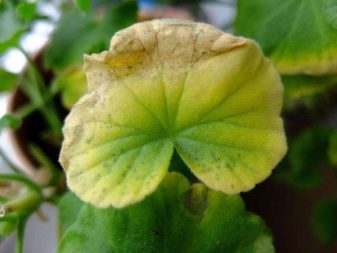
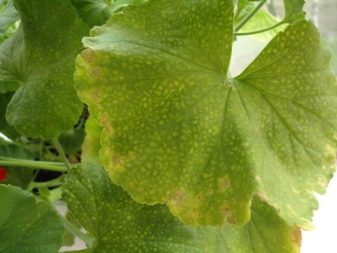
In addition to diseases, pelargonium can become a victim of pests.
- Aphid. Symptoms of the appearance of aphids - the leaves of pelargonium turn yellow and curl, the flowers are deformed, the plant is covered with something sticky. It is better to remove heavily damaged parts of the flower. Then the plant should be treated with an insecticide (for example, "Aklettikom"). In case of a particularly severe infection, the treatment should be repeated after about a week.
- Whitefly. These small white insects like to breed on the underside of the leaf. This insect is very dangerous for plants - it is a carrier of viruses, and its excrement provokes the appearance of sooty fungi. Both are dangerous for pelargonium. The way to combat whitefly is only insecticide treatment twice with a break a week.
- Mealybug. The external manifestation of the presence of this insect on the plant - the leaves and stems can be covered with something that vaguely resembles sugar coated with a fungus. The cause of this insect may be the lack of hygiene of the plant. To prevent its appearance, it is necessary to remove all dried or damaged parts of pelargonium in time and keep it clean.
In the fight against the worm, either soapy water or an insecticide will help. Spray the plant with insecticide, wipe it with soapy water. In both cases, you need to remove all secretions from the leaves and stems of the plant. If necessary, repeat the treatment in a month.
For information on how to care for terry pelargonium, see the next video.
Care rules
Pelargonium cannot be called picky or capricious, although it has its own requirements for the conditions of detention. Let's consider them.
The soil. Pelargonium loves neutral soil. You can buy a ready-made universal mixture for ornamental plants for her, but it is better to choose soil specifically for pelargonium. To increase the looseness of the soil and provide it with a good level of permeability of moisture and air, you need to add coarse sand to the soil.
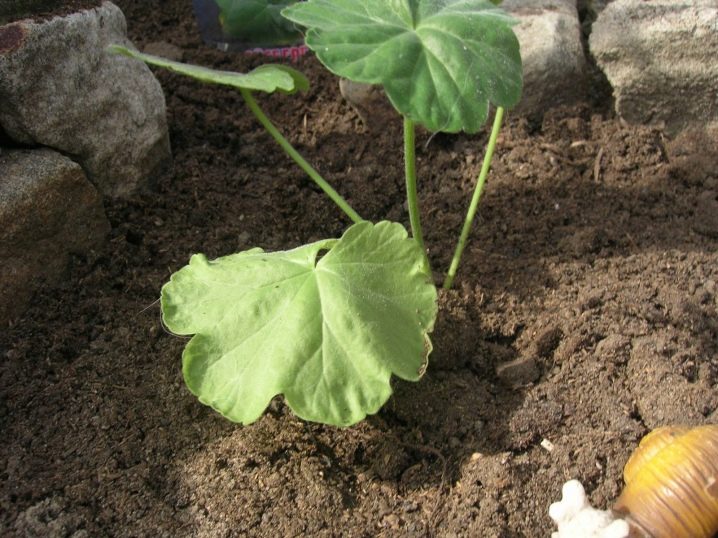
Lighting. Pelargonium is a light-loving plant. It tolerates direct sunlight and is therefore excellent for growing in flower beds when the climate permits. As a houseplant, pelargonium does not need to be placed in the sun. Glass causes a kind of greenhouse effect, which leads to overheating of the plant. Therefore, in the room, you need to choose a place for the pot where the plant will receive a sufficient amount of diffused and safe light for it.

Temperature. In summer, the plant feels comfortable at a temperature of 17-23 ° C, in winter - 6-15 ° C. If you do not observe the temperature regime, pelargonium will stop blooming or die. This applies to both too high and too low temperatures.
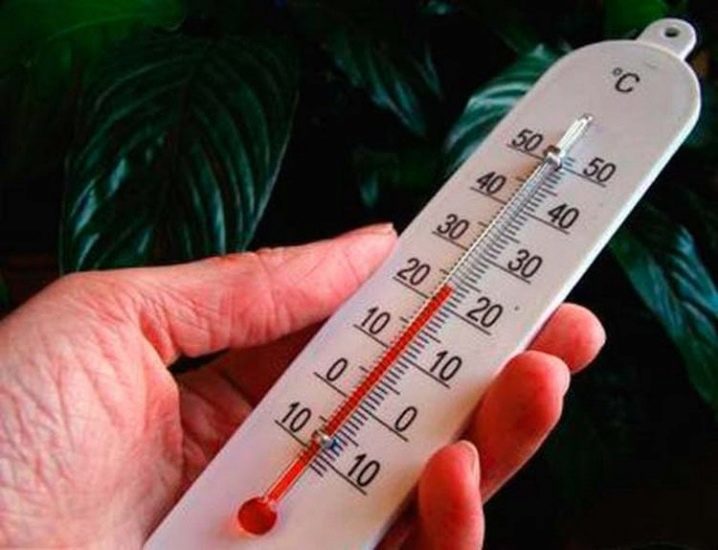
Watering. Watering the flowers is necessary when the top layer of soil in the pot dries out. The plant loves abundant watering. The soil must be constantly moistened
But it is important that the water does not stagnate in the soil. Therefore, looser soil is needed, plus a good drainage layer at the bottom of the pot.

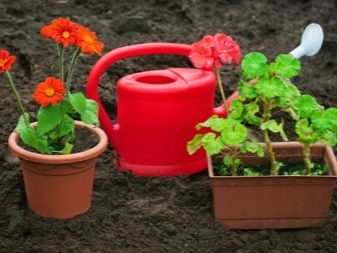
Top dressing. Pelargonium needs to be fed only during the flowering period. You cannot feed it with organic fertilizers, for example, manure, peat, compost and the like. It is better to choose special fertilizers for this type of plants and use them according to the instructions. The frequency of feeding the plant is twice a month.
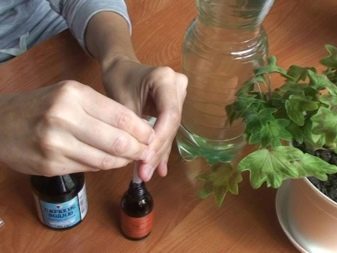
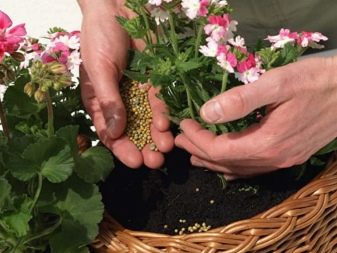
Pruning and replanting. It is necessary to prune pelargonium if the crown of its bushes becomes too lush. The abundance of leaves prevents the plant from being evenly saturated with light.
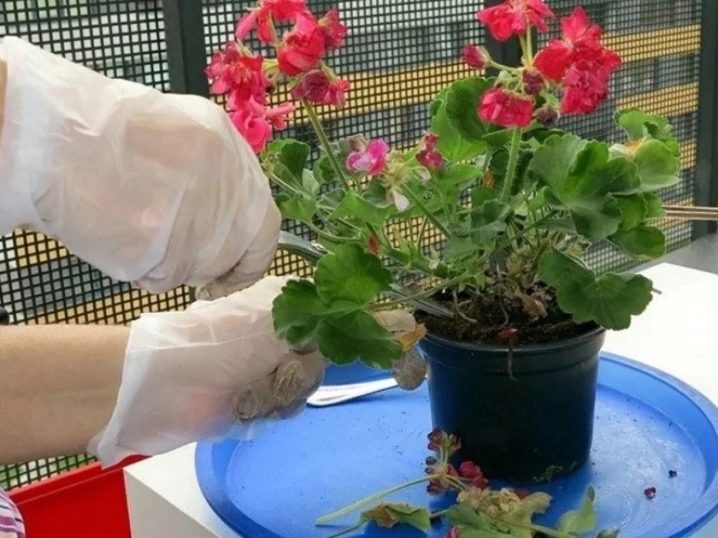
But pelargonium does not require planned transplants. Usually it is transplanted in urgent need. For example, in cases where:
- the plant was flooded with water;
- the pot is broken or damaged;
- the plant does not have enough space in the existing pot;
- the plant has just been purchased.
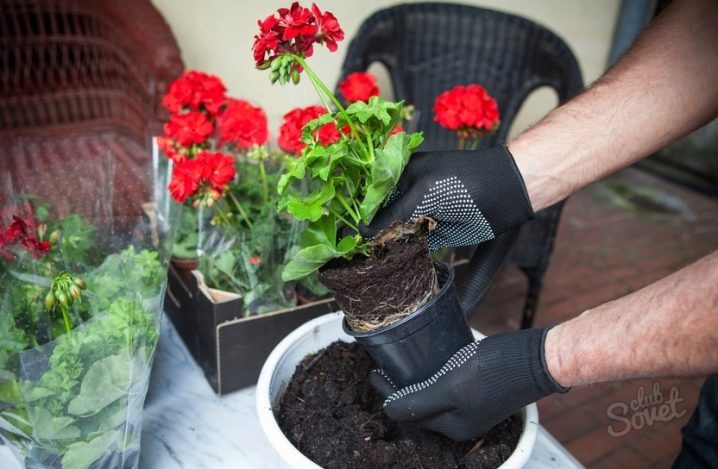
Separately, the issue of reproduction should be touched upon. Pelargonium propagates by cuttings and seeds.
Cutting is the easiest way. Cuttings are harvested in late summer or early autumn. To do this, they are cut off from an adult plant so that there are 4-5 leaves on the stem. The stalk must be placed in a container of water and wait for the roots to appear. When the stalk grows 2-3 cm roots, you can transplant it into your own pot of soil, and then care for it like an adult plant.
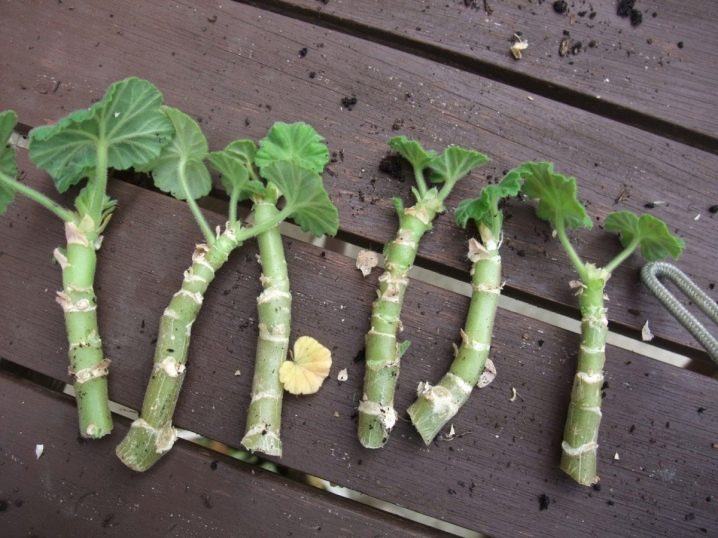
Experienced flower growers are engaged in the propagation of pelargonium from seeds.
Seeds can be bought, or you can collect them yourself. If you use the seeds of your home flower, you need to be prepared for the fact that the daughter plant will not have the distinctive features of its variety.
Before sowing, the seeds must be treated with fine sandpaper, and then soaked for two to three hours in warm water. In order for the seeds to germinate, after soaking, flower growers are advised to treat them with a preparation that stimulates root growth, for example, zircon.

Common diseases and pests
Pelargonium Salmon has good immunity, but if care is not taken, the flower can still get sick.
Anthracnose
The main symptom of this fungal disease is spotting. Hairy bulges of different colors appear on the leaves - brown, yellow, red, brown. The defeat of the disease occurs gradually.
- to save the flower, it is necessary to remove all affected areas;
- reduce air humidity;
- treat geranium with natural insecticides:
- copper sulfate;
- colloidal sulfur;
- bordeaux liquid.
Rust
A sign of rust is oval or round pustules on the inside of the leaf and red spots on top of the leaf blade.
This fungal disease provokes improper watering and excess air humidity.
The affected parts of the flower must be removed and the plant treated with fungicides.
Spotting and curling of leaves
Small spots appear on young leaves, which increase over time. The plant stops flowering. Curling the leaves indicates a malnutrition. The veins brighten and the edges dry.
Reference! To combat this ailment, it is necessary to use healthy plants for reproduction, and do not forget to regularly treat your pet with insecticides.
The most dangerous for Salmon pelargonium are aphids, whitefly, termite, caterpillar. To combat parasites, it is recommended to use the following drugs:
- aspirin;
- marathon;
- Monterey;
- messenger.


